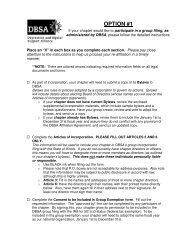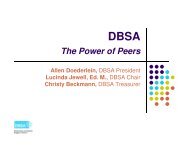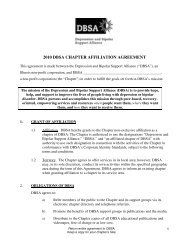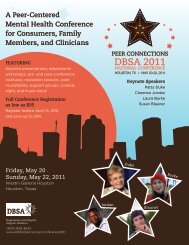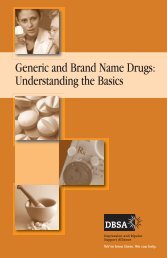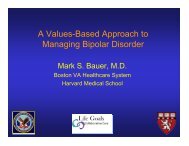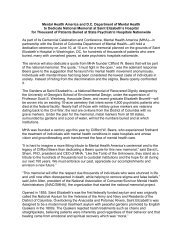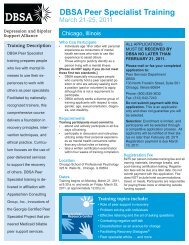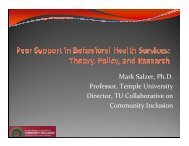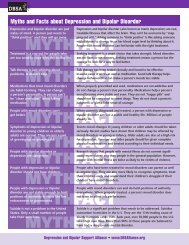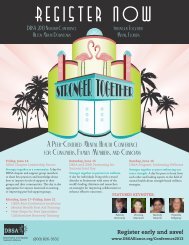Rhythms of Life - Depression and Bipolar Support Alliance
Rhythms of Life - Depression and Bipolar Support Alliance
Rhythms of Life - Depression and Bipolar Support Alliance
You also want an ePaper? Increase the reach of your titles
YUMPU automatically turns print PDFs into web optimized ePapers that Google loves.
GETTING IN THE RHYTHM:<br />
A Key to Practical Treatments <strong>of</strong><br />
Mood Disorders<br />
Holly A. Swartz, M.D.<br />
Associate Pr<strong>of</strong>essor <strong>of</strong> Psychiatry<br />
University <strong>of</strong> Pittsburgh School <strong>of</strong> Medicine
What does the<br />
body’s s clock<br />
have to do with<br />
moods <strong>and</strong><br />
mood<br />
disorders
The World Can Be<br />
Divided into<br />
Larks <strong>and</strong> Owls<br />
• The tendency to Lark-ness or Owl-ness is<br />
probably genetically determined<br />
• Thus, some people are more extreme in their<br />
morningness or eveningness than others<br />
• Regardless <strong>of</strong> how extreme one is, knowing<br />
one’s type <strong>and</strong> organizing one’s life to suit it<br />
can help improve mood, energy <strong>and</strong><br />
productivitiy
Circadian <strong>Rhythms</strong> <strong>and</strong> Mood<br />
Disorders<br />
Body clocks are sensitive to<br />
time shifts<br />
Makes it harder to stay<br />
on schedule
Pathways to<br />
Synchronize the<br />
Circadian System<br />
RHT=<br />
retinohypothalamic<br />
tract<br />
VLPO= ventrolateral<br />
preoptic nucleus<br />
SCN= suprachiasmatic<br />
nuclei<br />
Pin= pineal gl<strong>and</strong><br />
Pit= pituitary<br />
ACTH=<br />
Adrenocorticotropic<br />
hormone<br />
LC= locus ceruleus<br />
A=Adrenal gl<strong>and</strong><br />
Albrecht U. Annals <strong>of</strong> Medicine. 2010;<br />
42: 241–251
Interpersonal <strong>and</strong> Social<br />
Rhythm Therapy:<br />
Theoretical Rationale
Social Zeitgeber Hypothesis<br />
• Zeitgebers<br />
“Time keepers”<br />
Exogenous environmental factors that set<br />
the circadian clock<br />
Prototype = rising <strong>and</strong> setting <strong>of</strong> the sun<br />
• Social zeitgebers<br />
Social cues that set the circadian clock
Schema for Social Zeitgeber Theory <strong>of</strong> Moods <strong>and</strong> Mood Episodes<br />
<strong>Life</strong> Events<br />
Change in Social Prompts<br />
(Social Zeitgebers = Unobservable Variables)<br />
Change in Stability <strong>of</strong> Social <strong>Rhythms</strong><br />
Change in Stability <strong>of</strong> Biological <strong>Rhythms</strong><br />
Change in Somatic Symptoms<br />
Manic <strong>and</strong> Depressive Episodes = Pathological Entrainment <strong>of</strong><br />
Biological <strong>Rhythms</strong><br />
Ehlers, Frank & Kupfer. Arch Gen Psychiatry 1988;45:948-952.
<strong>Life</strong> Events<br />
Can provoke mood changes both through their<br />
psychological impact (life stress) <strong>and</strong>/or through<br />
disruption <strong>of</strong> an individual’s normal routines (social<br />
rhythm disruption).
Change in Social Prompts<br />
Consider, for example:<br />
• the loss <strong>of</strong> a beloved spouse<br />
• the loss <strong>of</strong> a not-so-beloved dog<br />
• a change in one’s <strong>of</strong>fice location with no<br />
change in one’s job<br />
• a change in one’s <strong>of</strong>fice location along with<br />
a major promotion
Change in Stability <strong>of</strong> Social <strong>Rhythms</strong><br />
• Death <strong>of</strong> a beloved spouse leads to psychological<br />
loss AND a loss <strong>of</strong> regular daily routines (e.g.<br />
wake time, meal times, other daily routines,<br />
bedtime)<br />
• Death <strong>of</strong> a not-so-beloved dog still involves a loss<br />
<strong>of</strong> regular daily routines
Change in Stability <strong>of</strong> Social <strong>Rhythms</strong><br />
• A move to a new <strong>of</strong>fice location without a change<br />
in responsibilities may still involve a major<br />
change in daily routines<br />
• A move to a new <strong>of</strong>fice location AND a change in<br />
responsibilities may involve psychological loss or<br />
disequilibrium AND a major change in daily<br />
routines
Change in Stability <strong>of</strong> Biological<br />
<strong>Rhythms</strong><br />
• Changes in wake time, the time at which one first<br />
becomes physically active, the time at which one<br />
first goes outside, meal times, bedtime, etc. lead<br />
to changes in internal biological rhythms<br />
including:<br />
• sleep<br />
• appetite<br />
• alertness<br />
• core body temperature<br />
• hormones including melatonin, cortisol
Change in Somatic Symptoms<br />
• Disequilibrium <strong>of</strong> our internal biological rhythms<br />
is experienced as somatic symptoms<br />
• Jet lag <strong>and</strong> the transition to or from Daylight<br />
Savings Time are good models for this array <strong>of</strong><br />
symptoms:<br />
• difficulty falling asleep at the ‘correct’ time<br />
• lack <strong>of</strong> appetite, nausea<br />
• lack <strong>of</strong> mental acuity, alertness<br />
• headache<br />
• irritability<br />
• Most people recover from jet lag or the DST<br />
transition within a few days, but…
Mood Symptoms =<br />
Pathological Entrainment <strong>of</strong> Biological <strong>Rhythms</strong><br />
• Individuals who are vulnerable to mood disorders<br />
become ‘stuck’ in this state <strong>of</strong> pathological<br />
entrainment <strong>and</strong> continue to experience the array <strong>of</strong><br />
symptoms we refer to as major depression<br />
• We hypothesized that treatments that<br />
re-entrain biological rhythms can speed recovery<br />
from mood disorders <strong>and</strong> prevent their return
The Social Rhythm Metric (SRM):<br />
An Instrument to Quantify the<br />
Daily <strong>Rhythms</strong> <strong>of</strong> <strong>Life</strong><br />
Monk et al J. Nervous <strong>and</strong> Mental<br />
Disease, 178: 120-126, 1990
5-Item Social Rhythm Metric (SRM)<br />
1. Out <strong>of</strong> bed<br />
2. First contact (in person or by phone…maybe via<br />
text or social media…it depends) with another<br />
3. Start work, school, housework, volunteer<br />
activities, child or family care<br />
4. Have dinner<br />
5. Go to bed
Social Rhythm Metric-II- Five-Item Version (SRM II – 5)<br />
Date (week <strong>of</strong>): _____________________<br />
Directions:<br />
Write the ideal target time you would like to do these daily activities.<br />
Record the time you actually did the activity each day.<br />
Record the people involved in the activity: 0 = Alone; 1 = Others present; 2 = Others actively involved; 3 = Others very stimulating<br />
Sunday Monday Tuesday Wednesday Thursday Friday Saturday<br />
Activity Target Time Time Time Time Time Time Time<br />
Time<br />
Out <strong>of</strong> bed<br />
People<br />
People<br />
People<br />
People<br />
People<br />
People<br />
People<br />
First contact<br />
with other<br />
person<br />
Start<br />
work/school/<br />
Volunteer/family<br />
care<br />
Dinner<br />
To bed<br />
Rate MOOD each day<br />
from -5 to +5<br />
- 5 = very depressed<br />
+5 = very elated
Social Rhythm Disruption Is a Stronger Predictor <strong>of</strong><br />
<strong>Bipolar</strong> Episode Onset than Psychological Stress<br />
70<br />
Patients (Percent)<br />
60<br />
50<br />
40<br />
30<br />
20<br />
10<br />
Total Group (N=39)<br />
Manic Subjects (N=20)<br />
Depressed Subjects (N=19)<br />
0<br />
Pre-onset<br />
Period<br />
Control<br />
Period<br />
Pre-onset<br />
Period<br />
Control<br />
Period<br />
Rhythm Disrupting Events<br />
Stressful Events<br />
Malk<strong>of</strong>f-Schwartz et al. Arch Gen Psychiatry 55:702-707, 1998
Essential Elements <strong>of</strong> Interpersonal <strong>and</strong><br />
Social Rhythm Therapy (IPSRT)<br />
• Social rhythm therapy¹<br />
Regularize daily routines<br />
Emphasizes the link between regular routines <strong>and</strong> moods<br />
Uses Social Rhythm Metric to monitor routines<br />
• Interpersonal psychotherapy²<br />
Emphasizes link between mood <strong>and</strong> life events<br />
Focus on interpersonal problem area (grief, role transition,<br />
role disputes, interpersonal deficits)<br />
1. Frank E, et al. Biol Psychiatry 2000;48:593-604; Frank E, et al, Arch Gen Psychiatry 62:996-<br />
1004, 2005.<br />
2. Klerman GL, et al. Interpersonal Psychotherapy <strong>of</strong> <strong>Depression</strong>, Basic Books, New York, 1984.
Maintenance Therapies in<br />
<strong>Bipolar</strong> Disorder: Study Design<br />
Acute Treatment: Variable Length<br />
IPSRT<br />
<strong>and</strong><br />
protocol pharmacotherapy<br />
Strategy #1#<br />
Maintenance Treatment: 2 yrs<br />
IPSRT<br />
<strong>and</strong><br />
protocol pharmacotherapy<br />
175 acutely ill<br />
patients enter<br />
study <strong>and</strong><br />
are r<strong>and</strong>omly<br />
assigned<br />
Intensive clinical<br />
management <strong>and</strong><br />
protocol pharmacotherapy<br />
IPSRT<br />
<strong>and</strong><br />
protocol pharmacotherapy<br />
Intensive clinical<br />
management <strong>and</strong><br />
protocol pharmacotherapy<br />
Strategy #2#<br />
Strategy #3#<br />
Strategy #4#<br />
Intensive clinical<br />
management <strong>and</strong><br />
protocol pharmacotherapy<br />
Intensive clinical<br />
management <strong>and</strong><br />
protocol pharmacotherapy<br />
IPSRT<br />
<strong>and</strong><br />
protocol pharmacotherapy<br />
IPSRT: Interpersonal <strong>and</strong> Social Rhythm Therapy
Maintenance Therapies in <strong>Bipolar</strong> Disorder:<br />
Key Outcomes<br />
• Acute IPSRT was associated with significantly<br />
more rapid improvement in occupational<br />
functioning (p
STEP-BD PSYCHOSOCIAL<br />
TREATMENT OF ACUTE<br />
DEPRESSION: STUDY DESIGN<br />
• 293 acutely depressed patients with bipolar I or<br />
II disorder were r<strong>and</strong>omly assigned to intensive<br />
treatment (up to 30 sessions <strong>of</strong> FFT, CBT, or<br />
IPSRT over 9 months) or a brief control<br />
treatment (CC).<br />
• Each site provided two <strong>of</strong> the intensive<br />
treatments <strong>and</strong> CC<br />
• Only patients with family members were eligible<br />
for assignment to FFT<br />
• Primary outcome: time to “recovered” status (< 2<br />
moderate symptoms for 8 weeks)
Remission 110 days earlier with intensive<br />
psychotherapy<br />
110 Days
STEP-BD TIME TO RECOVERED STATUS:<br />
IPSRT VS. CONTROL<br />
Miklowitz et al, Archives <strong>of</strong> General<br />
Psychiatry, 2007
Would maintaining regular<br />
social rhythms help all <strong>of</strong> us<br />
to feel better
Greater Social Rhythm Regularity is<br />
Associated with Better Sleep Quality<br />
Monk et al. Chronobiol Int 20:97-107, 2003
QUESTIONS<br />
COMMENTS



